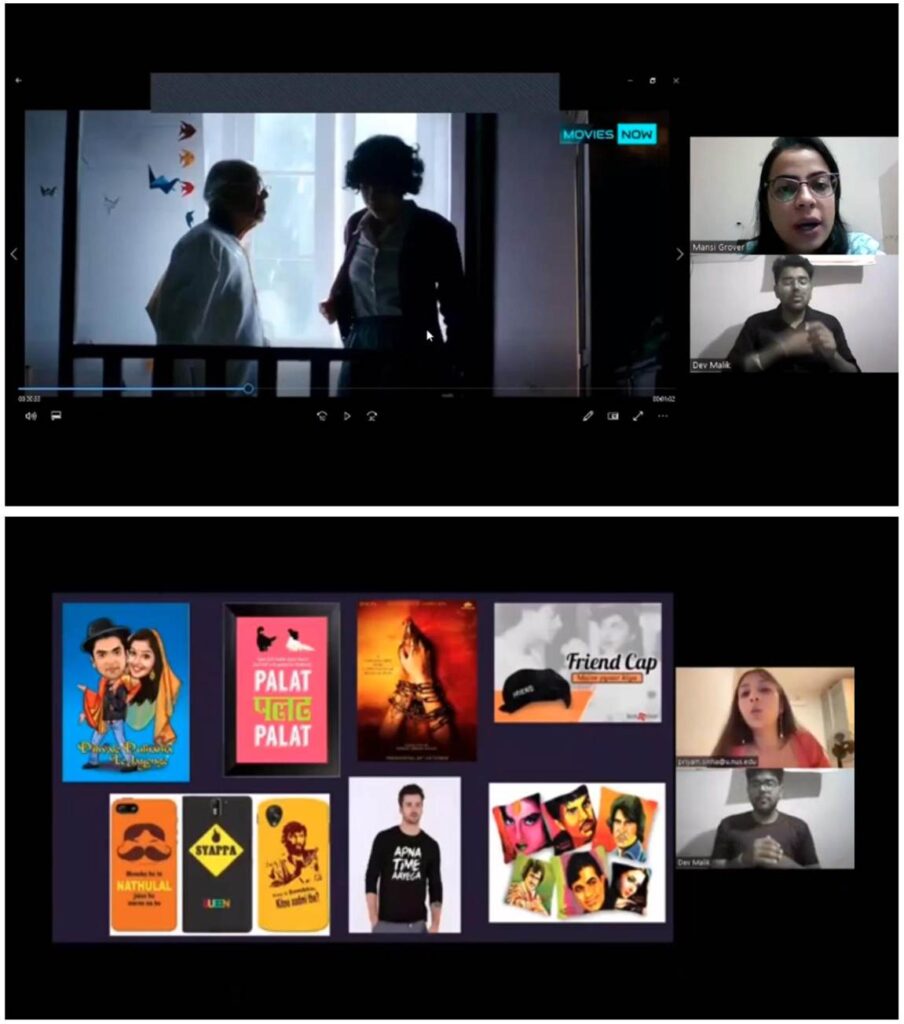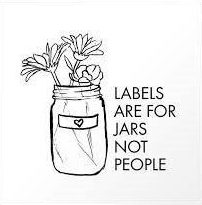CENTRE FOR DISABILITY RESEARCH AND TRAINING, KIRORI MAL COLLEGE, UNIVERSITY OF DELHI
Presents
DRISHTIKON 2.0
A WEEK LONG ONLINE WORKSHOP ON DISABILITY AND HINDI CINEMA
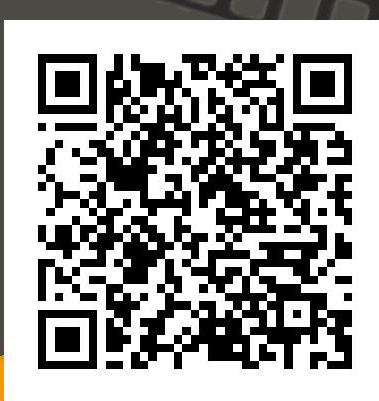
Scan here to know how to register
Priyam Sinha
July 4 – July 9, 2022
(L) 6:00 PM-8:00 PM
Online Mode
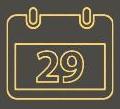
Last Date to Register: June 29,2022
PATRON:
Prof. Vibha S. Chauhan
Principal, Kirori Mal College
CENTRE FOR DISABILITY RESEARCH AND TRAINING, KIRORI MAL COLLEGE, UNIVERSITY OF DELHI
DRISHTIKON 2.0
A WEEK LONG WORKSHOP ON DISABILITY AND HINDI CINEMA
HOW TO REGISTER?
- The registration fee for the workshop is Rs. 251/-. This is to be paid via NEFT/IMPS/UPI to the following account:
Bank Name : Punjab National Bank (PNB)
Bank Address : Kirori Mal College, University of Delhi, Delhi – 110007
Account Name : Kirori Mal College General Fund A/C
Account No of Beneficiary : 51522010003240 (NEFT/RTGS/Act. Tfr. )
IFSC Code : PUNB0515210
- After making the payment, download/take a screenshot of the payment receipt.
- Participants are required to fill the registration form by clicking here.
- Please ensure that you have proof of payment before filling up the registration form and attach it while filling the form.
- Last Date of Registration is 29th June, 2022.
- Other information will be conveyed to the registered candidates via email.
- Please note, there are limited seats and we shall follow the policy of first-come-first serve. Hence, before making the payment, check whether the registration is still open.
- Certificates will be issued only to candidates who have
attendance and have successfully submitted their assignments.
PATRON:
Prof. Vibha S. Chauhan
Principal, Kirori Mal College
ORGANISER:
Prof. Someshwar Sati Co-ordinator, CDRT
Report
Drishtikon 2.0: Disability and Hindi Cinema
The 6-day-long workshop Drishtikon 2.0 began as a curated series of interactive, audio-visual sets of events forming the foundation of disability and Hindi cinema. Although it was conducted online (zoom), there were 107 registrations, of which 88 succeeded in completing the workshop requirements. The criteria for certifying their participation were interaction and engagement during its sessions while we noted their names and, most importantly, submission of a 500 -word abstract which we intend to collate as a book. The sequence of events for each session put forth a simple breakdown of the readings uploaded on google drive, a link made accessible to all participants. The lesson plan clearly outlined a set of compulsory and optional readings and separate folders for each lecture. We ensured that the participants would not have to find them and could thus understand what was being discussed in the workshops. We demonstrated the central arguments of the readings using illustrations, providing an insight into its character arcs, plot and shot division, often bolstered with short video clips from movies and song sequences.
Further, we ensured that the sign language interpreters were in sync with the session lectures to enable a disability-inclusive online platform. Upon receiving the feedback on providing an oral description of film sequences for the visually challenged, we instantly worked upon it to ensure that the workshop foregrounded a nuanced understanding of disability and cinema for all its participants. The WhatsApp group created for the participants also helped us clarify any added concerns. The resource persons also introduced questions between each theoretical discussion to ensure that the participants were engaged throughout the session and could comprehend what was being spoken about. So, we charted out themes like Disability and Sexuality, fundamentals of Hindi cinema, models of disability in India, visible and invisible disabilities, deafness and blindness, feminist disability studies, disability and masculinity, and narrative prosthesis.
Thus, drawing upon a comprehensive dialogue on the interconnections between cinema, culture and society in underlining all these intersectional pedagogies in Disability Studies and Hindi formed the crux of the sessions. Forty minutes of every session at the end were solely devoted to an open platform for clarifying doubts, reflection on what was discussed and questions/ answers where participants put forth their concerns and understanding of disability portrayals in Hindi cinema. Often, many discussions went beyond the allocated time as the participants were very engaged throughout the session. In sum, the six sessions put for a comprehensive dialogue in unpacking the fundamentals of viewing cinema, particularly the disability gaze constructed in Hindi cinema. The participants were also expected to send the abstract from the list of themes as options shared with them in the lesson plan, and they were also free to reach out for clarity on the submission. Most of them submitted their abstracts, many of which are very well structured and organised.
Priyam Sinha and Mansi Grover
Resource Persons
Drishtikon 2.0
Disability and Hindi Cinema Schedule
Session Lecturers
Priyam Sinha (PhD Research Scholar, National University of Singapore)
Mansi Grover (PhD Research Scholar, Jamia Milia Islamia University)
Dates: July 2022
Time: 6-8pm
Venue: Zoom
Day 1: 4 July 2022: Introductory Session: Key Concepts of Disability and Hindi Cinema Lecture by: Priyam Sinha: Key Concepts of Disability and Hindi Cinema
Session Outline:
- Key concepts within Disability Studies and its various models- like the religious, social, charity and rehabilitation in the Global South by focussing on India as an ethnographic field of study.
- A brief history of Hindi cinema, the transition from Bombay to Bollywood cinema.
- Basics of masculinity and femininity representation in Hindi cinema, some celebrated star bodies (like wife-whore dyad, avenging woman, glorified motherhood, new woman and women-centric cinema, angry young man, tapori, classic Muslim social, the projected NRI culture) and their picturisation since the 1930s.
- The Disability Gaze: How it was introduced in Bollywood cinema and Why?
Youtube Link: https://youtu.be/hsUlyv04KkU
Day 2: 5 July 2022: Reading the Basics of Disability Studies Through Hindi Cinema Lecture by: Mansi Grover
Session Outline:
The following session would take up the basics of Disability Studies and would problematize the concept of normalcy at large. It would then look at visible and sensory disabilities and would contest the idea of universal Disability Studies.
- Introducing Disability Studies by problematizing the fundamental binary of ability/disability, normal/abnormal.
- Ableism and Ableist gaze; Disability as a construct
- Myth of body perfection; deconstructing the desire for a diaphanous body
- An overview of Disability Studies in the West; Decolonizing the Western models of Disability Studies
- Visible Sensory Disability- Blindness and Deafness
- Fixing and Curing Disability
Youtube Link: https://youtu.be/WI6wFM86VeE
Day 3: 6 July 2022: Disability and Sexuality
Lecture by: Priyam Sinha
Session Outline:
- Culture of disablism, crip theory and narrative prosthesis discuss how disability cinema constructs a tragic/outlier status despite producing more disability-centred films.
- What have some actors said about performing disability onscreen, directorial vision and the uniqueness of curating disability and dialogue on sexual minorities in Bollywood?
Youtube Link: https://youtu.be/5DTU8v7emjg
Day 4: 7 July 2022: “Mai tumhare layak nahi hu”: Exploring the Representation of
Physical Disability through Hindi Cinema
Lecture by: Mansi Grover
Session Outline:
The following session would go further into the study of visible disabilities such as physical disability, congenital as well as acquired. It would further look at the concept of monstrosity and freak shows.
- Disability and Femininity; Disability and Masculinity
- Evaluative gaze
- Affective Study of Disability
- Physical Disability, Acquired Disability
- Prosthetics and Cyborg
- Body Alienation; Debates surrounding Euthanasia
- The idea of Quality of Life
- Old-age
YouTube Link: https://youtu.be/YkgG8KpODYY
Day 5: 7 July 2022: On Invisible Disability
Lecture by: Mansi Grover
Session Outline:
The following session would look into invisible disabilities such as intellectual and mental disabilities. It would further look into films that have represented mental disabilities but were never recognized as films dealing with a disability. The aim is to rethink these films through a disability studies lens.
- Autism Spectrum – Savant Syndrome
- Autism and Caregiving; Autism and Motherhood
- Representation of Autism in films
- Mental Disability
- Trauma and Mental Health
- Normality Genre
YouTube Link: https://youtu.be/la5umiozm88
Day 6: 7 July 2022: “Parde ke aagey aur peeche kya hai?”: Nuances of Hindi cinema and how it portrays the disability and sexuality dialogue
Lecture by: Priyam Sinha:
Session Outline:
- What goes behind the craft of disability cinema?: Bollywood as an assemblage.
- Discuss some popular Hindi cinema and how disability was shown in them.
- It is also tapping into some reviews and works on how disability cinema is becoming prominent.
Closing remarks: How cinema, culture and society are interwoven in producing disablism.
YouTube Link: https://youtu.be/668QHGmlIfo
ASSIGNMENT
500 Words Abstract
- Disability and Sexuality
- Disability and Masculinity
- Queering Disability
- Disability and Caste
- Disability and Feminism
- Disability and Friendship
- Disability and Romance
- Disability and Sibling Relations
- Disability: Song and Dance
- Disability and Regional Cinema
- Disability and Documentaries
- Disability and Comedy
KMC Disability Research Centre
Disability and Hindi Cinema Lesson Plan
Session Lecturers
Priyam Sinha (PhD Research Scholar, National University of Singapore)
Mansi Grover (PhD Research Scholar, Jamia Milia Islamia University)
Dates: 4-9 July 2022
Time: 6-8pm
Venue: Zoom details will be shared
Day 1
Introductory Session
Lecture by: Priyam Sinha: Key Concepts of Disability and Hindi Cinema
Session Outline:
- Key concepts within Disability Studies and its various models- like the religious, social, charity and rehabilitation in the Global South by focussing on India as an ethnographic field of study.
- A brief history of Hindi cinema, the transition from Bombay to Bollywood cinema.
- Basics of masculinity and femininity representation in Hindi cinema, some celebrated star bodies (like wife-whore dyad, avenging woman, glorified motherhood, new woman and women-centric cinema, angry young man, tapori, classic Muslim social, the projected NRI culture) and their picturisation since the 1930s.
- The Disability Gaze: How it was introduced in Bollywood cinema and Why?
Compulsory Readings:
- Contours of Ableism: The Production of Disability and Abledness (Fiona Kumari Campbell), pg 3-29.
- Disability in South Asia-Millennium to Millennium (M. Miles)
- Measuring Disability in India (Roger Jeffery, Nidhi Singhal)
- The Ghettoization of Disability: Paradoxes of Visibility and Invisibility in Cinema (Lennard J. Davis)
- The ‘Bollywoodization’ of the Indian cinema: cultural nationalism in a global arena (Ashish Rajadhyaksha)
- The Dilemma of Disabled Masculinity (Russell Shuttleworth, Nikki Wedgwood, and Nathan J. Wilson)
- Misfits: A feminist materialist disability concept (Rosemarie Garland-Thomson)
- Slippery subjects: gender, meaning and the Bollywood audience (Shakuntala Banaji)
- The politics of cinematic representation of disability: “the psychiatric gaze”(Ranjita Dawn)
- Diverting diseases (Madhava Prasad)
Additional Readings:
- Writing histories of disability in India: strategies of Inclusion (Jane Buckingham)
- At the intersection of disability and masculinity: exploring gender and bodily difference in India (James Staples)
- Decolonising disability: thinking and acting globally (Helen Meekosha)
- The Globalisation of Bollywood: An ethnography of non-elite audiences in India (Shakuntala Rao)
Films to be used: Bajrangi Bhaijaan, Bhool Bhulaiyaa, Atrangi Re, Taare Zameen Par, My Name is Khan, Paa, Hichki
Day 2
Lecture by: Mansi Grover: Reading the Basics of Disability Studies Through Hindi Cinema
Session Outline:
The following session would take up the basics of Disability Studies and would problematize the concept of normalcy at large. It would then look at visible and sensory disabilities and would contest the idea of universal Disability Studies.
- Introducing Disability Studies by problematizing the fundamental binary of ability/disability, normal/abnormal.
- Ableism and Ableist gaze; Disability as a construct
- Myth of body perfection; deconstructing the desire for a diaphanous body
- An overview of Disability Studies in the West; Decolonizing the Western models of Disability Studies
- Visible Sensory Disability- Blindness and Deafness
- Fixing and Curing Disability
Readings:
Compulsory Readings
- Renu Addlakha “Introduction” in Disability Studies in India: Global Discourses, Local Realities
- David Bolt. “The Metanarrative of Disability” in Routledge Handbook of Disability
- Tanya Titchkosky “Disability Studies: The Old and the New”
Additional Readings
- Isabel Santaolalla “Bodyscapes of Silence: The Figure of the Mute Woman in the Cinema”
- Oliver Sacks “To See or Not See.”
- Jyotika Virdi “Reverence, Rape-and then Revenge: Popular Hindi Cinema’s “Women’s Films”.” in Killing Women: The Visual Culture of Gender and Violence
- Jyotika Virdi. “The Idealized Woman.” in The Cinematic Imagination: Indian Popular Films as Social History
- Brenda Jo Brueggemann. “Think-Between: A Deaf Studies Commonplace Book.” Open Your Eyes: Deaf Studies Talking, edited by H-Dirksen L. Bauman, University of Minnesota Press, 2008, pp. 177-188.
- Georgina Kleege. Sight Unseen
- Brenda Jo Brueggemann “Deaf, She Wrote: Mapping Deaf Women’s Autobiography”
- Michele Friedner “Understanding and Not-Understanding: What Do Epistemologies and Ontologies Do in Deaf Worlds?”
- Thomas G. Couser, “Disability, Life Narrative, and Representation”
- Limaye, Sandhya. “The Inner World of Adolescent Girls with Hearing Impairment: Two Case Studies” in Disability Studies in India: Global Discourses, Local Realities
- Jepson, Jill. “Some Aspects of the Deaf Experience in India”
- Robert Hoffmeister “Border Crossings by Hearing Children of Deaf Parents: The Lost History of Codas.” Open your Eyes: Deaf Studies Talking, pp. 189-215.
Day 3
Lecture by: Priyam Sinha: Disability and Sexuality
Session Outline:
- Culture of disablism, crip theory and narrative prosthesis discuss how disability cinema constructs a tragic/outlier status despite producing more disability-centred films.
- What have some actors said about performing disability onscreen, directorial vision and the uniqueness of curating disability and dialogue on sexual minorities in Bollywood?
Compulsory Readings:
- Disabling sex: Notes for a crip theory of sexuality (Robert McRuer)
- Physical disability and Indian Cinema (Joyojeet Pal)
- Bollywood Portrayals of Women With Disabilities (Meenu Bhambhani)
Optional Readings:
- Compulsory Bodies: Reflections on Heterosexuality and Able-bodiedness (Alison Kafer)
- Narrative Prosthesis (David Mitchell and Sharon Snyder)
- A in Sex and Disability (Tobin Siebers chapter) pg 37-53 Sexual Culture for Disabled People
Films: Saajan, Sadma, Black, Golmaal, Ghajini, Iqbal, Mann, Pushpa, Barfi, Chup Chupke, Zero, Housefull 3, Mujhse Shaadi Karogi, Judaai, Shubh Mangal Zyada Saavdhan.
Day 4
Lecture by: Mansi Grover: “Mai tumhare layak nahi hu”: Exploring the Representation of Physical Disability through Hindi Cinema
Session Outline:
The following session would go further into the study of visible disabilities such as physical disability, congenital as well as acquired. It would further look at the concept of monstrosity and freak shows.
- Disability and Femininity; Disability and Masculinity
- Evaluative gaze
- Affective Study of Disability
- Physical Disability, Acquired Disability
- Prosthetics and Cyborg
- Body Alienation; Debates surrounding Euthanasia
- The idea of Quality of Life
- Old-age
Readings:
Compulsory Readings
- Bill Hughes “Fear, Pity and Disgust: Emotions and the Non-Disabled Imaginary.” Routledge Handbook of Disability Studies, edited by N. Watson, A. Roulstone and C. Thomas, Routledge, 2012, pp. 67-78.
- Anita Ghai, “Disabled Women: An Excluded Agenda of Indian Feminism”
- Susannah B. Mintz “A Brief History of Aging” Unruly Bodies: Life Writing With Disabilities
Additional Readings
- Donna J. Haraway “A Cyborg Manifesto: Science, Technology, and Socialist-Feminism in the Late Twentieth Century”
- David T. Mitchell and Sharon L. Snyder. “Body Genres and Disability Sensations: The Challenge of the New Disability Documentary Cinema.” Cultural Locations of Disability, edited by David T. Mitchell and Sharon L. Snyder, The University of Chicago Press, 2006, pp. 156-183.
- Rosemarie Garland-Thomson, Staring: How We Look.
- Susan Lonsdale, Women and Disability: The Experience of Physical Disability Among Women. The Macmillan Press Ltd., 1990.
- Steven Kurzman “‘There’s no language for this’: Communication and Alignment in Contemporary Prosthetics”, Disability and Society: A Reader, edited by Renu Addlakha et al., Orient Blackswan, 2009.
- Amartya Sen and Martha Nussbaum, The Quality of Life
- Susan Wendell, The Rejected Body: Feminist Philosophical Reflections on Disability. Routledge, 1996.
Films: Jailor, Dosti, Arzoo, Sholay, Chandni, Nache Mayuri, Satyam Shivam Sundaram, Khoon Bhari Maang, Lagaan, Chhapaak, Earth 1947, Guzaarish, Guru, The Sky is Pink
Day 5
Lecture by: Mansi Grover: On Invisible Disability
Session Outline:
The following session would look into invisible disabilities such as intellectual and mental disabilities. It would further look into films that have represented mental disabilities but were never recognized as films dealing with a disability. The aim is to rethink these films through a disability studies lens.
- Autism Spectrum – Savant Syndrome
- Autism and Caregiving; Autism and Motherhood
- Representation of Autism in films
- Mental Disability
- Trauma and Mental Health
- Normality Genre
Readings:
Compulsory Readings
- Nilika Mehrotra and Shubhangi Vaidya. “Exploring Constructs of Intellectual Disability and Personhood in Haryana and Delhi”
- Shilpaa Anand “Historicising Disability in India: Questions of Subject and Method”
- Anu Aneja and Shubhangi Vaidya. “‘More than a Mother’: Autism, motherhood discourse and lived experience”
- Bhargavi V. Davar “From Mental Illness to Disability: Choices for Women Users/ Survivors of Psychiatry in Self and Identity Constructions”
Additional Readings
- Michele Fine and Adrienne Asch. Women with Disabilities: Essays in Psychology, Culture and Politics.
- Upali Chakravarti “Burden of Caring: Families of the Disabled in Urban India”
- Eva Feder Kittay, Learning from My Daughter: The Value and Care of Disabled Minds
- Nandini Ghosh. “Bhalo Meye: Cultural Construction of Gender and Disability in Bengal”
- Stuart Murray, Representing Autism
- Paul Darke, “Understanding Cinematic Representations of Disability” in Disability Reader: Social Science Perspective
Films: Karz, Karan Arjun, Bhrashtachar, Barfi, Sadmaa, Tehzeeb, Main Aisa Hi Hoon, 15
Park Avenue, The Sky is Pink
Day 6
Lecture by: Priyam Sinha: “Parde ke aagey aur peeche kya hai?”: Nuances of Hindi cinema and how it portrays the disability and sexuality dialogue
Session Outline:
- What goes behind the craft of disability cinema?: Bollywood as an assemblage.
- Discuss some popular Hindi cinema and how disability was shown in them.
- It is also tapping into some reviews and works on how disability cinema is becoming prominent.
Compulsory Readings:
- The essential Bollywood (Jigna Desai and Rajinder Dudrah)
- Engaging with disability with postcolonial theory (Anita Ghai in Disability and Social Theory) : pg: 270-286
- Disorder, disability, difference: (Re) presenting autism in India (Shubhangi Vaidya in Disability Studies in India): pg: 43-60.
- Queering Bollywood (Gayathri Gopinath)
Optional Readings:
- Bollywood’s India (Priya Joshi)
- The meanings of ‘Bollywood’ (Ravi Vasudevan)
- Untimely Bollywood: Globalization and India’s New Media Assemblage (Amit S. Rai)
Films to be used: Barfi, Fanaa, Margarita with a Straw, Guzaarish, Kaminey, Omkara, Bhairavi, Lipstick Under My Burkha, Wazir, My Brother Nikhil.
Presentation and Discussion
In the last two days, one hour would also be spent on having presentations, discussions and review
We divide the students and have two platforms for presentation and discussion, review and feedback on what has been put across and after ten days you can send us your writeup to which we will send detailed feedback.
Minimum: 1 Film and how disability has been represented in it. This becomes a forum for CFP and can eventually be converted into a book. The themes are not restricted to Hindi cinema.
Topics are for reference and do not limit the participant to work on some theme beyond this list:
- Disability and Sexuality
- Disability and Masculinity
- Queering Disability
- Disability and Caste
- Disability and Feminism
- Disability and Friendship
- Disability and Romance
- Disability and Sibling Relations
- Disability: Song and Dance
- Disability and Regional Cinema
- Disability and Documentaries
- Disability and Comedy
- Closing remarks: How cinema, culture and society are interwoven in producing disablism.
PHOTOGRAPHS
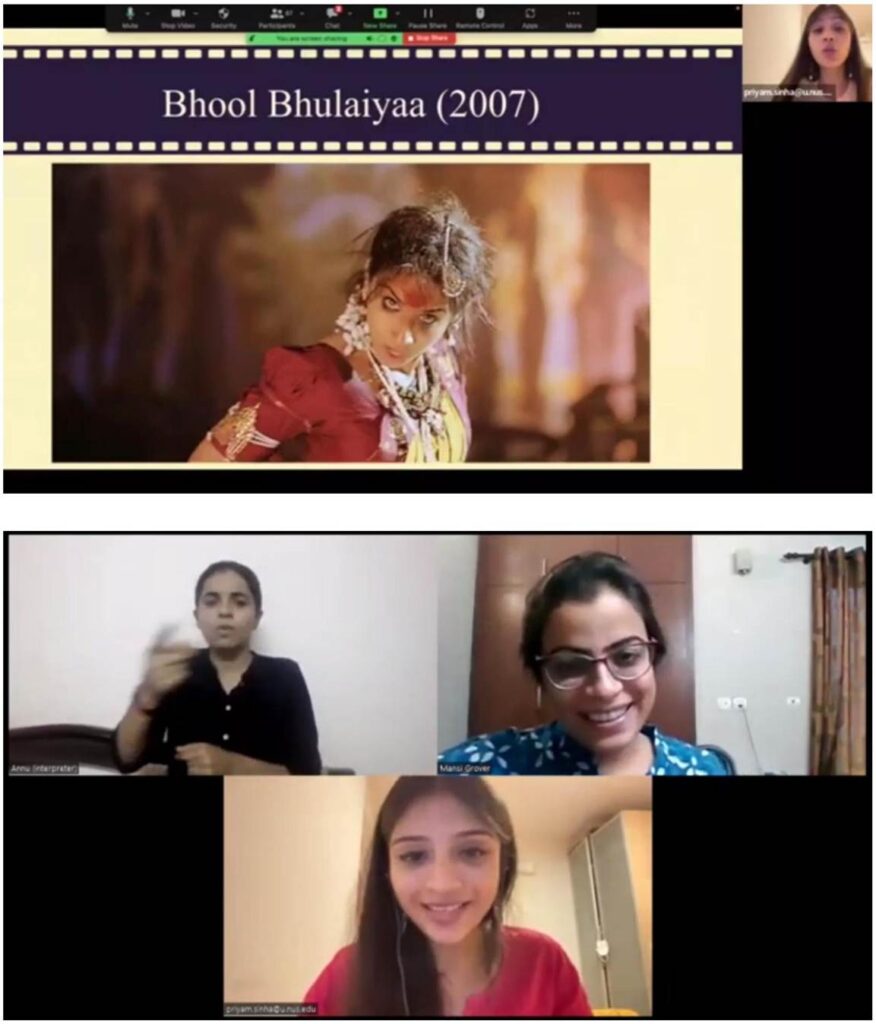
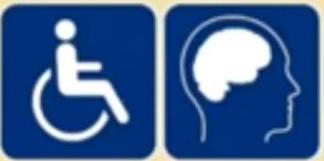
Drishtikon: Session 3
合果
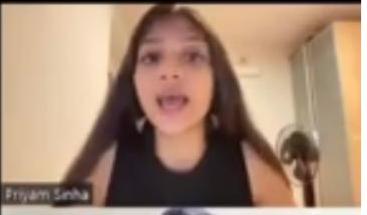
Centre for Disability Research and Training
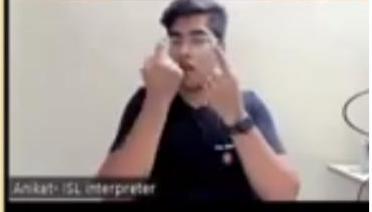
Disability and Sexuality
-Priyam Sinha (priyam.sinha(q u nus. cdu)
How does a disabled body affect the status quo?

Annu (interpreter)
